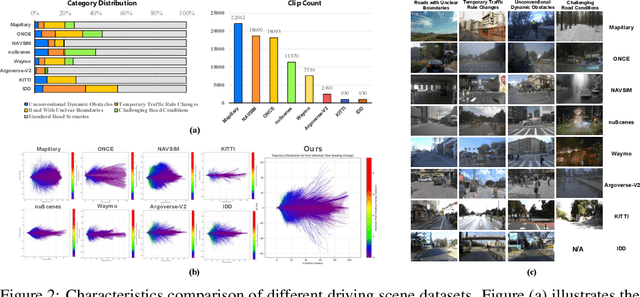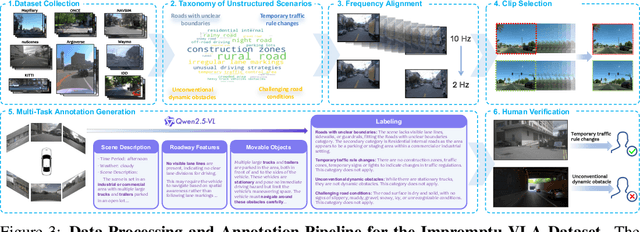Hang Zhao
DAP: A Discrete-token Autoregressive Planner for Autonomous Driving
Nov 17, 2025Abstract:Gaining sustainable performance improvement with scaling data and model budget remains a pivotal yet unresolved challenge in autonomous driving. While autoregressive models exhibited promising data-scaling efficiency in planning tasks, predicting ego trajectories alone suffers sparse supervision and weakly constrains how scene evolution should shape ego motion. Therefore, we introduce DAP, a discrete-token autoregressive planner that jointly forecasts BEV semantics and ego trajectories, thereby enforcing comprehensive representation learning and allowing predicted dynamics to directly condition ego motion. In addition, we incorporate a reinforcement-learning-based fine-tuning, which preserves supervised behavior cloning priors while injecting reward-guided improvements. Despite a compact 160M parameter budget, DAP achieves state-of-the-art performance on open-loop metrics and delivers competitive closed-loop results on the NAVSIM benchmark. Overall, the fully discrete-token autoregressive formulation operating on both rasterized BEV and ego actions provides a compact yet scalable planning paradigm for autonomous driving.
Surfel-based 3D Registration with Equivariant SE(3) Features
Aug 28, 2025Abstract:Point cloud registration is crucial for ensuring 3D alignment consistency of multiple local point clouds in 3D reconstruction for remote sensing or digital heritage. While various point cloud-based registration methods exist, both non-learning and learning-based, they ignore point orientations and point uncertainties, making the model susceptible to noisy input and aggressive rotations of the input point cloud like orthogonal transformation; thus, it necessitates extensive training point clouds with transformation augmentations. To address these issues, we propose a novel surfel-based pose learning regression approach. Our method can initialize surfels from Lidar point cloud using virtual perspective camera parameters, and learns explicit $\mathbf{SE(3)}$ equivariant features, including both position and rotation through $\mathbf{SE(3)}$ equivariant convolutional kernels to predict relative transformation between source and target scans. The model comprises an equivariant convolutional encoder, a cross-attention mechanism for similarity computation, a fully-connected decoder, and a non-linear Huber loss. Experimental results on indoor and outdoor datasets demonstrate our model superiority and robust performance on real point-cloud scans compared to state-of-the-art methods.
* 5 pages, 4 figures
DriveAgent-R1: Advancing VLM-based Autonomous Driving with Hybrid Thinking and Active Perception
Jul 28, 2025Abstract:Vision-Language Models (VLMs) are advancing autonomous driving, yet their potential is constrained by myopic decision-making and passive perception, limiting reliability in complex environments. We introduce DriveAgent-R1 to tackle these challenges in long-horizon, high-level behavioral decision-making. DriveAgent-R1 features two core innovations: a Hybrid-Thinking framework that adaptively switches between efficient text-based and in-depth tool-based reasoning, and an Active Perception mechanism with a vision toolkit to proactively resolve uncertainties, thereby balancing decision-making efficiency and reliability. The agent is trained using a novel, three-stage progressive reinforcement learning strategy designed to master these hybrid capabilities. Extensive experiments demonstrate that DriveAgent-R1 achieves state-of-the-art performance, outperforming even leading proprietary large multimodal models, such as Claude Sonnet 4. Ablation studies validate our approach and confirm that the agent's decisions are robustly grounded in actively perceived visual evidence, paving a path toward safer and more intelligent autonomous systems.
Reusing Attention for One-stage Lane Topology Understanding
Jul 23, 2025Abstract:Understanding lane toplogy relationships accurately is critical for safe autonomous driving. However, existing two-stage methods suffer from inefficiencies due to error propagations and increased computational overheads. To address these challenges, we propose a one-stage architecture that simultaneously predicts traffic elements, lane centerlines and topology relationship, improving both the accuracy and inference speed of lane topology understanding for autonomous driving. Our key innovation lies in reusing intermediate attention resources within distinct transformer decoders. This approach effectively leverages the inherent relational knowledge within the element detection module to enable the modeling of topology relationships among traffic elements and lanes without requiring additional computationally expensive graph networks. Furthermore, we are the first to demonstrate that knowledge can be distilled from models that utilize standard definition (SD) maps to those operates without using SD maps, enabling superior performance even in the absence of SD maps. Extensive experiments on the OpenLane-V2 dataset show that our approach outperforms baseline methods in both accuracy and efficiency, achieving superior results in lane detection, traffic element identification, and topology reasoning. Our code is available at https://github.com/Yang-Li-2000/one-stage.git.
Morpheus: A Neural-driven Animatronic Face with Hybrid Actuation and Diverse Emotion Control
Jul 22, 2025Abstract:Previous animatronic faces struggle to express emotions effectively due to hardware and software limitations. On the hardware side, earlier approaches either use rigid-driven mechanisms, which provide precise control but are difficult to design within constrained spaces, or tendon-driven mechanisms, which are more space-efficient but challenging to control. In contrast, we propose a hybrid actuation approach that combines the best of both worlds. The eyes and mouth-key areas for emotional expression-are controlled using rigid mechanisms for precise movement, while the nose and cheek, which convey subtle facial microexpressions, are driven by strings. This design allows us to build a compact yet versatile hardware platform capable of expressing a wide range of emotions. On the algorithmic side, our method introduces a self-modeling network that maps motor actions to facial landmarks, allowing us to automatically establish the relationship between blendshape coefficients for different facial expressions and the corresponding motor control signals through gradient backpropagation. We then train a neural network to map speech input to corresponding blendshape controls. With our method, we can generate distinct emotional expressions such as happiness, fear, disgust, and anger, from any given sentence, each with nuanced, emotion-specific control signals-a feature that has not been demonstrated in earlier systems. We release the hardware design and code at https://github.com/ZZongzheng0918/Morpheus-Hardware and https://github.com/ZZongzheng0918/Morpheus-Software.
FocusDiff: Advancing Fine-Grained Text-Image Alignment for Autoregressive Visual Generation through RL
Jun 05, 2025Abstract:Recent studies extend the autoregression paradigm to text-to-image generation, achieving performance comparable to diffusion models. However, our new PairComp benchmark -- featuring test cases of paired prompts with similar syntax but different fine-grained semantics -- reveals that existing models struggle with fine-grained text-image alignment thus failing to realize precise control over visual tokens. To address this, we propose FocusDiff, which enhances fine-grained text-image semantic alignment by focusing on subtle differences between similar text-image pairs. We construct a new dataset of paired texts and images with similar overall expressions but distinct local semantics, further introducing a novel reinforcement learning algorithm to emphasize such fine-grained semantic differences for desired image generation. Our approach achieves state-of-the-art performance on existing text-to-image benchmarks and significantly outperforms prior methods on PairComp.
DiffDecompose: Layer-Wise Decomposition of Alpha-Composited Images via Diffusion Transformers
May 30, 2025Abstract:Diffusion models have recently motivated great success in many generation tasks like object removal. Nevertheless, existing image decomposition methods struggle to disentangle semi-transparent or transparent layer occlusions due to mask prior dependencies, static object assumptions, and the lack of datasets. In this paper, we delve into a novel task: Layer-Wise Decomposition of Alpha-Composited Images, aiming to recover constituent layers from single overlapped images under the condition of semi-transparent/transparent alpha layer non-linear occlusion. To address challenges in layer ambiguity, generalization, and data scarcity, we first introduce AlphaBlend, the first large-scale and high-quality dataset for transparent and semi-transparent layer decomposition, supporting six real-world subtasks (e.g., translucent flare removal, semi-transparent cell decomposition, glassware decomposition). Building on this dataset, we present DiffDecompose, a diffusion Transformer-based framework that learns the posterior over possible layer decompositions conditioned on the input image, semantic prompts, and blending type. Rather than regressing alpha mattes directly, DiffDecompose performs In-Context Decomposition, enabling the model to predict one or multiple layers without per-layer supervision, and introduces Layer Position Encoding Cloning to maintain pixel-level correspondence across layers. Extensive experiments on the proposed AlphaBlend dataset and public LOGO dataset verify the effectiveness of DiffDecompose. The code and dataset will be available upon paper acceptance. Our code will be available at: https://github.com/Wangzt1121/DiffDecompose.
Diffusion-Based Generative Models for 3D Occupancy Prediction in Autonomous Driving
May 29, 2025Abstract:Accurately predicting 3D occupancy grids from visual inputs is critical for autonomous driving, but current discriminative methods struggle with noisy data, incomplete observations, and the complex structures inherent in 3D scenes. In this work, we reframe 3D occupancy prediction as a generative modeling task using diffusion models, which learn the underlying data distribution and incorporate 3D scene priors. This approach enhances prediction consistency, noise robustness, and better handles the intricacies of 3D spatial structures. Our extensive experiments show that diffusion-based generative models outperform state-of-the-art discriminative approaches, delivering more realistic and accurate occupancy predictions, especially in occluded or low-visibility regions. Moreover, the improved predictions significantly benefit downstream planning tasks, highlighting the practical advantages of our method for real-world autonomous driving applications.
Impromptu VLA: Open Weights and Open Data for Driving Vision-Language-Action Models
May 29, 2025



Abstract:Vision-Language-Action (VLA) models for autonomous driving show promise but falter in unstructured corner case scenarios, largely due to a scarcity of targeted benchmarks. To address this, we introduce Impromptu VLA. Our core contribution is the Impromptu VLA Dataset: over 80,000 meticulously curated video clips, distilled from over 2M source clips sourced from 8 open-source large-scale datasets. This dataset is built upon our novel taxonomy of four challenging unstructured categories and features rich, planning-oriented question-answering annotations and action trajectories. Crucially, experiments demonstrate that VLAs trained with our dataset achieve substantial performance gains on established benchmarks--improving closed-loop NeuroNCAP scores and collision rates, and reaching near state-of-the-art L2 accuracy in open-loop nuScenes trajectory prediction. Furthermore, our Q&A suite serves as an effective diagnostic, revealing clear VLM improvements in perception, prediction, and planning. Our code, data and models are available at https://github.com/ahydchh/Impromptu-VLA.
Designing Pin-pression Gripper and Learning its Dexterous Grasping with Online In-hand Adjustment
May 25, 2025Abstract:We introduce a novel design of parallel-jaw grippers drawing inspiration from pin-pression toys. The proposed pin-pression gripper features a distinctive mechanism in which each finger integrates a 2D array of pins capable of independent extension and retraction. This unique design allows the gripper to instantaneously customize its finger's shape to conform to the object being grasped by dynamically adjusting the extension/retraction of the pins. In addition, the gripper excels in in-hand re-orientation of objects for enhanced grasping stability again via dynamically adjusting the pins. To learn the dynamic grasping skills of pin-pression grippers, we devise a dedicated reinforcement learning algorithm with careful designs of state representation and reward shaping. To achieve a more efficient grasp-while-lift grasping mode, we propose a curriculum learning scheme. Extensive evaluations demonstrate that our design, together with the learned skills, leads to highly flexible and robust grasping with much stronger generality to unseen objects than alternatives. We also highlight encouraging physical results of sim-to-real transfer on a physically manufactured pin-pression gripper, demonstrating the practical significance of our novel gripper design and grasping skill. Demonstration videos for this paper are available at https://github.com/siggraph-pin-pression-gripper/pin-pression-gripper-video.
 Add to Chrome
Add to Chrome Add to Firefox
Add to Firefox Add to Edge
Add to Edge